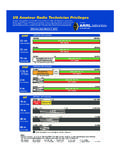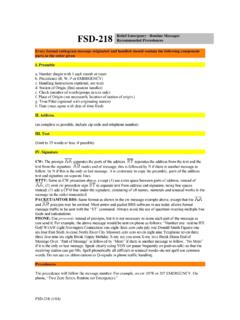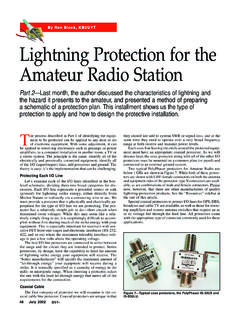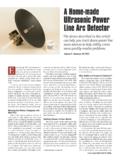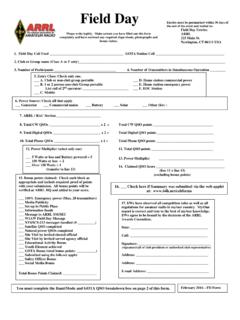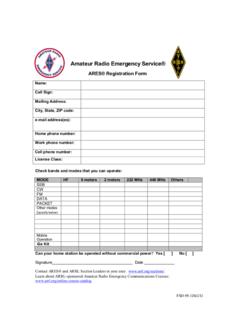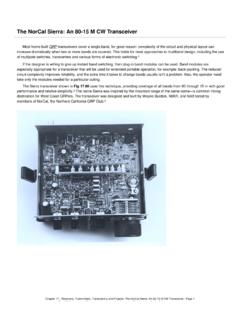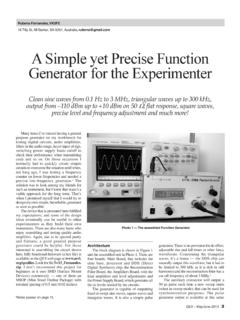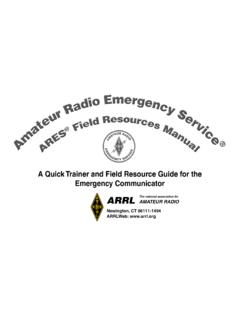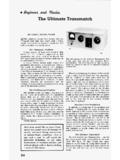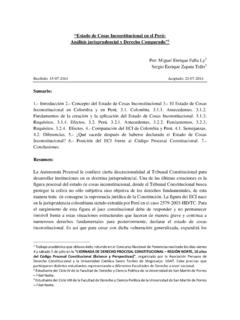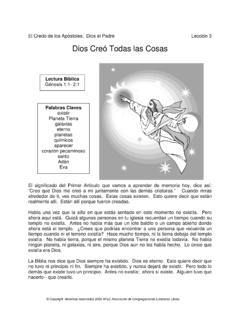Transcription of The Amateur Radio Parity Act: Setting the Record …
1 The Amateur Radio Parity Act: Setting the Record straight ARRL has been diligently working toward passage of the Amateur Radio Parity Act (ARPA) for the past 3 and a half years. Our view is that this legislation is, in its current form, extremely beneficial and necessary right now for many thousands of Radio amateurs, and for future generations of hams. The future of Amateur Radio is indeed dim without it. Now, 90 percent of new housing starts in the United States are subject to private land-use restrictions. Virtually all of these have provisions that either prohibit outdoor Amateur Radio antennas outright, or else subject amateurs to the unlimited discretion of Homeowners Associations (HOAs) which can, and almost always do, reject requests for outdoor antennas (except over the air video delivery antennas, which they can t prohibit any longer due to Congressional action in 1996). When FCC enacted its PRB-1 policy in 1985 for municipal land-use regulation of Amateur antennas, it refused to apply the no prohibition, reasonable accommodation, least practicable restriction requirements of that policy to private land-use regulations.
2 That was a mistake by FCC then, and ARRL has been working toward fixing it ever since. We now have a chance to do that. But placing Federal restrictions on private land-use regulations is not an easy task. Covenants and deed restrictions or CC&Rs, as they are commonly referred to have been found enforceable for centuries because they are restrictions placed on the land itself, and bind all subsequent owners of that land. While the FCC does have the jurisdiction to limit covenants where they conflict with Federal telecommunications policy, that jurisdiction is exercised very seldom. The ARPA is necessary in order to cause FCC to exercise that jurisdiction. The ARPA, in the form passed by the House last session ( 1301) and passed again in January of this year without dissent ( 555), and which is now before the Senate ( ) is actually far better than the rather vague provisions of PRB-1, which necessitated a good deal of litigation since 1985.
3 The Parity Act would literally guarantee every single Radio Amateur who lives in a deed-restricted community the right to erect and maintain an effective outdoor antenna on property under the exclusive use or control of the licensee, regardless of what the covenants say. That is an exceptional benefit to the many thousands of hams living in deed-restricted communities. Some self-appointed experts on this subject have recently suggested that the legislation is flawed for various reasons. It is time to set the Record straight . Here are a few myths about ARPA, debunked. Q. Deed restrictions are agreed to by hams when they buy property regulated by an HOA. Why shouldn t hams be required to abide by the agreements they voluntarily entered into? A. There are several answers to this. (1) Courts have held that covenants are subject to being limited or even invalidated where they conflict with Federal telecommunications policy.
4 (2) In many instances, one can t know whether an HOA will or will not allow an antenna in advance of buying the property and applying for one, so they haven t agreed to forego Amateur Radio just by buying land. (3) Often, hams have no choice where to buy property due to family, job, and school locations. Many become licensed after already purchasing property in a deed-restricted community. The proliferation of covenants limits their options and precludes the use of their FCC licenses. Q. ARPA gives HOAs the right to use aesthetics as a basis for antenna decisions, even where HOA rules do not now have any provisions concerning antennas. Doesn t this give HOAs an entitlement that they don t now have? A. No. Deed restrictions are based solely on aesthetics. The reason they are required by lenders for land use developers is that the lender wants to make sure that the aesthetics of the neighborhood don t change until the developer sells all the lots in the subdivision and pays the lender back.
5 HOAs have always been able to regulate aesthetic impact of land uses; it is not something conferred by ARPA. ARPA is simply stating the situation as it is now and has always been. FCC has held that private land-use regulations are entitled to less deference than zoning regulations because covenants address aesthetic concerns while zoning addresses both safety and aesthetics. There are very, very few declarations of covenants that do not include antenna regulations. Now, and going forward, virtually all do, because lenders require them. Q. ARPA requires a deed-restricted Amateur to notify and seek prior approval from an HOA before installing any outdoor antenna, with no grandfathering of those already installed. Why? A. Because HOA rules and covenants almost exclusively provide for prior approval of structures anyway. In the zoning context, antenna approvals are always based on a building permit application.
6 The situation with accessory structures is no different in the HOA context. HOAs have a legitimate interest in the aesthetic impact of antenna installations, and while they have to allow an Amateur an effective outdoor antenna under ARPA, that entitlement is not unlimited. As to grandfathering, there is no backward application of ARPA proposed. If one already has an approved antenna in a deed-restricted community, nothing else is required. If one has a non-approved antenna that violates the covenants, the Amateur can choose to continue with that, or to avail himself or herself of the entitlement to be provided by the FCC rules enacted pursuant to ARPA to legitimize the antenna. Q. ARPA does not require a time limit on HOAs for approval or disapproval of a particular antenna proposal. Couldn t an HOA stall indefinitely without any adverse consequence? A. No, although the question reflects a misunderstanding of the proper role of legislation.
7 There is no indication that an HOA has ever simply failed to adjudicate an antenna proposal and no indication that a timetable is necessary. Even if that was a real issue, not all details of implementation of ARPA should be specified in the legislation. ARPA merely calls on FCC to implement the policy within a fixed time frame. FCC has to do rulemaking to do that. The details of the implementation are for FCC to address. However, even if FCC didn t do that, and the rules implementing ARPA were adopted without imposing a time limit on HOAs, an indefinite stall would violate the entitlement to an effective outdoor antenna and the Amateur could enforce the entitlement in court. Q. Why does ARPA not guarantee an Amateur the right to operate on the band(s) of his or her choice? A. This argument is a bit hard to understand. FCC licenses entitle a Radio Amateur to operate on a wide variety of Amateur allocations.
8 The entitlement to operate on all Amateur bands or to maintain antennas that are effective on all Amateur bands at the same time is far beyond the scope of either PRB-1 or ARPA. There is a very definite limit to what is achievable in any legislative limitation on private land-use regulation. It simply is an unreasonable expectation that any legislation will invalidate covenants completely and allow a Radio Amateur to erect whatever he or she wishes to install. That said, an Amateur s expectation for the types of effective outdoor antenna that the HOA will be obligated to permit differs depending on the type of land use involved. In a condominium, perhaps a whip antenna on a balcony is the best that can be accommodated. On a 10-acre, single family lot in a deed-restricted, wooded subdivision, a far more elaborate antenna and support structure should be expected. The specification of the need to operate on multiple bands throughout the Radio spectrum is not a matter that is properly included in legislative language.
9 It will have to be addressed in FCC rulemaking or in report language accompanying the legislation. Q. I have heard a lawyer mention CC&Rs that empower HOAs only to maintain roads, utilities, or landscaping, with no power to regulate antennas. If ARPA passes, wouldn t that HOA be able to demand that an Amateur seek its approval to install Amateur antennas? Why create Federal approval obligations where they don t now exist under the covenants? A. There are several answers to this: (1) Those limited CC&Rs are few and far between. The normal provision of CC&Rs and virtually all new ones now include prohibitions on, or complete control by the HOA of antennas. Worrying about HOAs without antenna jurisdiction is the tail wagging the dog. (2) If a Radio Amateur who lives in a deed-restricted community where the CC&Rs do not empower an HOA to regulate antennas chooses to not avail himself or herself of the provisions of the FCC rules enacted pursuant to ARPA, there is no obligation to do that.
10 Nor would the FCC rule create any new jurisdiction that is not conferred on the HOA by the declaration of covenants, from where the HOA derives its authority. No FCC enforcement agent is going to sanction a ham because he or she didn t contact their HOA before putting up an antenna. Q. Because the preamble to the legislation distinguishes ARPA from PRB-1, would the court decisions applying PRB-1 apply to the FCC rules adopted pursuant to ARPA? A. That is not entirely clear. There are similarities between PRB-1 and ARPA, in that ARPA would preempt the application to hams of covenants which, on their face or as applied, preclude communications in the Amateur Radio or Amateur Satellite Services and where the covenants do not constitute the minimum practicable restriction on such communications to accomplish the lawful purposes of an HOA (which are aesthetics). Where ARPA is actually better for hams than PRB-1 is that ARPA includes a specific guarantee of an effective outdoor antenna for every ham in a deed-restricted community.
